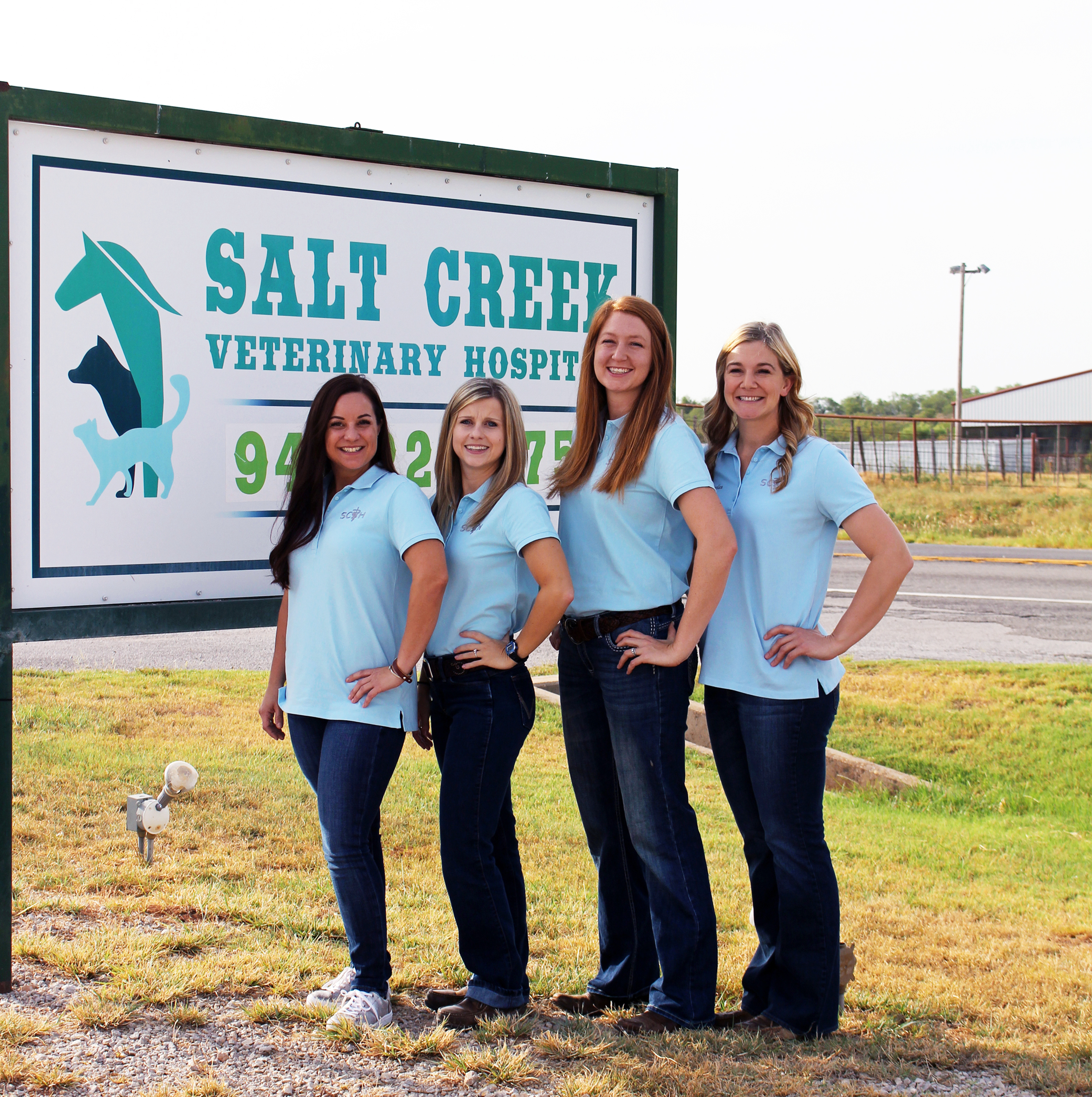Country Lifestyles
Practicing as a Team – Salt Creek/Countryside Veterinary Hospital

By Jessica Crabtree
At 7 a.m. every Monday morning at the local cafe in Olney, Texas, in the far back corner a group of ladies gather over breakfast. At first glance nothing seems unusual, until you overhear their conversations about farrowing piglets, pregnancy checking cattle, the most recent weekend veterinarian emergencies, and more.
That’s right—those four ladies are all veterinarians, representing the Salt Creek/Countryside Veterinarian Hospitals in Olney, Graham and Seymour.
The three veterinary clinics are managed by an all-women staff including Keelan (Anderson) Lewis, DVM; Carrie Foltyn, DVM; Brittany Thompson, DVM; and Amy Eiland, DVM. Lewis is a veterinarian’s daughter, Dr. Arn Anderson of Bowie, Texas. Never intending to follow in her father’s footsteps, the seven-year veterinarian began her own practice with her father’s support in 2011.
Dr. Lewis was a somewhat “pioneer” in her industry when she embarked seven years ago. “When I first came to Olney, no one had ever seen a young vet, let alone a female vet,” Lewis explained. “While it was a challenge, the town was welcoming, and through the years a trust developed.”
Generationally speaking, a rural mixed animal veterinary practice was typically made up of one male vet and few employees with limited to no associates. The struggles of the profession across the board are many—long days, a hefty work load demanding constant attention, as well as a high emotional, physical and mental commitment. Considering that kind of pressure, a notable change in the profession is occurring.
According to the American Veterinary Medical Foundation, as of 2017 veterinarians in the U.S. totaled 110,531. Of those 66,731 were women. According to the American Veterinary Medical Association, the current ratio is 55 percent female/45 percent male in the veterinary market (private and public).
To read more pick up a copy of the September 2018 NTFR issue. To subscribe call 940-872-5922.
Country Lifestyles
While We Were Sleeping

By Martha Crump
That old adage, “What you don’t know won’t hurt you.,” may have some basis in truth when applied to minor situations. However, when what you don’t know is presented in the form of a “Trojan Horse” and is what amounts to an incredible attempt to fleece American property rights, it becomes a different story altogether.
To put this unbelievable tale together, we need to step back to Joe Biden’s 2021 Executive Order which pledged commitment to help restore balance on public lands and waters, to create jobs, and to provide a path to align the management of America’s public lands and waters with our nation’s climate, conservation, and clean energy goals.
To read more, pick up a copy of the April issue of NTFR magazine. To subscribe by mail, call 940-872-5922.
Country Lifestyles
Lacey’s Pantry: Strawberry Sorbet

By Lacey Vilhauer
Ingredients:
1 whole lemon, seeded and roughly chopped
2 cups sugar
2 pounds strawberries, hulled
Juice of 1 to 2 lemons
¼ cup water
Directions:
Place the chopped lemon and sugar in a food processor and pulse until combined. Transfer to a large bowl. Puree the strawberries in a food processor and add to the lemon mixture along with juice of one lemon and water. Taste and add more juice as desired.
To read more, pick up a copy of the April issue of NTFR magazine. To subscribe by mail, call 940-872-5922.
Country Lifestyles
A Mountain Out of a Molehill

By Nicholas Waters
As winter plods along – come Spring and gopher mounds – homeowners and farmers find themselves playing a familiar song – fiddling while Rome is burning.
Let’s make a mountain out of a molehill. Those mounds on your lawn and pasture could be moles, but they’re more than likely gophers; Plains Pocket Gophers to be pragmatic – Geomys bursarius to be scientific.
These rodents dig and chew, and the damage they can do goes beyond the mounds we mow over. Iowa State University cited a study in Nebraska showing a 35 percent loss in irrigated alfalfa fields due to the presence of pocket gophers; the number jumped to 46 percent in decreased production of non-irrigated alfalfa fields.
The internet is replete with academic research from coast-to-coast on how to curtail gopher populations, or at least control them. Kansas State University – then called Kansas State Agricultural College – also published a book [Bulletin 152] in February 1908 focused exclusively on the pocket gopher.
To read more, pick up a copy of the April issue of NTFR magazine. To subscribe by mail, call 940-872-5922.
-

 Country Lifestyles1 year ago
Country Lifestyles1 year agoScott & Stacey Schumacher: A Growth Mindset
-

 Equine7 months ago
Equine7 months agoThe Will to Win
-

 Country Lifestyles7 years ago
Country Lifestyles7 years agoStyle Your Profile – What your style cowboy hat says about you and new trends in 2017
-

 Country Lifestyles4 years ago
Country Lifestyles4 years agoAmber Crawford, Breakaway Roper
-

 HOME7 years ago
HOME7 years agoGrazing North Texas – Wilman Lovegrass
-

 Country Lifestyles7 years ago
Country Lifestyles7 years agoDecember 2016 Profile, Rusty Riddle – The Riddle Way
-

 Country Lifestyles8 years ago
Country Lifestyles8 years agoJune 2016 Profile – The man behind the mic: Bob Tallman
-

 Outdoor9 years ago
Outdoor9 years agoButtercup or Primrose?






